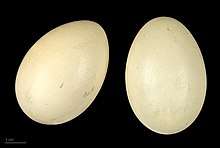Yellow-billed teal
The yellow-billed teal (Anas flavirostris) is a South American species of duck. Like other teals, it belongs to the diverse genus Anas; more precisely it is one of the "true" teals of subgenus Nettion.[2][3][4] It occurs in Argentina, the Falkland Islands, Chile, Peru, Bolivia, Uruguay, and Brazil. It has also established itself in South Georgia, where it was first recorded breeding in 1971, and has been recorded as far east as Tristan da Cunha. It inhabits freshwater wetlands, preferring palustrine habitat to rivers. Considering its wide range and local abundance, it is not considered threatened by the IUCN.[1][5]
| Yellow-billed teal | |
|---|---|
| Sharp-winged teal, A. f. oxyptera | |
| Scientific classification | |
| Kingdom: | Animalia |
| Phylum: | Chordata |
| Class: | Aves |
| Order: | Anseriformes |
| Family: | Anatidae |
| Genus: | Anas |
| Species: | A. flavirostris |
| Binomial name | |
| Anas flavirostris Vieillot, 1816 | |
| Subspecies | |
| |

Taxonomy
Mitochondrial DNA sequence data is most similar to that of the very different-looking green-winged teal.[note 1] Apart from the mystifying relationship with the red-and-green-headed teals, it altogether most resembles the Indian Ocean radiation of teals. However, the yellow-billed teal's unicolored underside and namesake bill are unique, as is to be expected from a species that evolved half a world apart from Bernier's or the grey teal.[2]
This species is also unique among its relatives in some aspects of its post-copulation behavior: After dismounting, the drakes stretch themselves up high and swim around and alongside the females.[4]
Traditionally, there are 2 subspecies:
- Sharp-winged teal, Anas flavirostris oxyptera (Meyen, 1834) – highlands of central Peru to northern Chile and Argentina.
- Chilean teal, Anas flavirostris flavirostris (Vieillot, 1816) – southern South America as far north as southern Brazil and northern Argentina. Also in the Falkland Islands.
Previously, this species and the Andean teal formed the superspecies speckled teal, but increasingly taxonomists consider the two species distinct.[6]
Footnotes
- Johnson & Sorenson (1999); see there for a discussion of the crecca-carolinensis-flavirostris group's phylogeny.
References
- BirdLife International (2013). "Anas flavirostris". IUCN Red List of Threatened Species. 2013. Retrieved 26 November 2013.CS1 maint: ref=harv (link)
- Carboneras, Carles (1992). "77. Speckled Teal". In del Hoyo, Josep; Elliott, Andrew; Sargatal, Jordi (eds.). Handbook of Birds of the World, Volume. 1: Ostrich to Ducks. Barcelona: Lynx Edicions. pp. 603, plate 45. ISBN 84-87334-10-5.
- Johnson, Kevin P. & Sorenson, Michael D. (1999). "Phylogeny and biogeography of dabbling ducks (genus Anas): a comparison of molecular and morphological evidence" (PDF). Auk. 116 (3): 792–805. doi:10.2307/4089339. JSTOR 4089339.
- Johnson, Kevin P. McKinney, Frank; Wilson, Robert & Sorenson, Michael D. (2000). "The evolution of postcopulatory displays in dabbling ducks (Anatini): a phylogenetic perspective" (PDF). Animal Behaviour. 59 (5): 953–963. doi:10.1006/anbe.1999.1399. PMID 10860522.CS1 maint: multiple names: authors list (link)
- Accordi, Iury Almeida; Barcellos, André (2006). "Composição da avifauna em oito áreas úmidas da Bacia Hidrográfica do Lago Guaíba, Rio Grande do Sul" [Bird composition and conservation in eight wetlands of the hydrographic basin of Guaíba lake, State of Rio Grande do Sul, Brazil] (PDF). Revista Brasileira de Ornitologia (in Portuguese and English). 14 (2): 101–115.
- Remsen, Van (2008). "Treat Anas andium as a separate species from Anas flavirostris". South American Classification Committee. Retrieved 27 April 2008.
